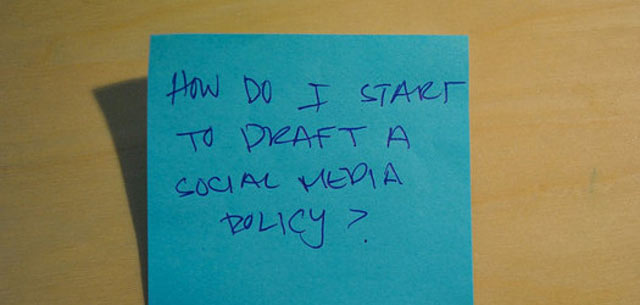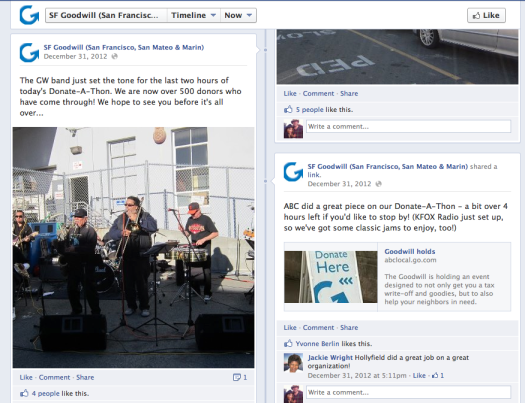
Draft a comprehensive set of guidelines to cover all of your social media bases
Target audience: Nonprofits, cause organizations, foundations, NGOs, social enterprises, businesses, educators. Note: Socialbrite has created social media policies for a number of nonprofit clients.
Guest post by Andrea Berry and Ben Stuart
Idealware
As nonprofits have increasingly turned to social media, policies to govern their use have become the new frontier. It can be difficult for organizations to find examples that fit their needs. A good social media policy will provide clear guidelines as to what staff should and shouldn’t do when posting and interacting with the community on a day-to-day basis, freeing them up to think more strategically. But what’s involved in creating one?
A good social media campaign or engagement strategy can help your organization fulfill its mission, and there are many examples of nonprofits using these tools successfully for everything from fundraising and volunteer recruitment to building awareness. But there are also examples of organizations that have encountered pitfalls along the way to an effective social media presence.
How do you avoid such a fate? By developing a policy that provides guidelines for how and when to use social media, you can save staff time, improve the effectiveness of your efforts, and limit the risk of other potential problems before they arise.
What your policy covers, and to what to extent, will vary based on your particular needs, but the foundation is the same. Let’s look at the different components one at a time.
Defining policy within your organization
What should your social media policy say and do? That’s going to depend on your organization’s particular needs. For some nonprofits, a policy should spell out what staff can and cannot do on different social media channels by creating strategically defined roles governed by hard-and-fast rules. For others, a policy is a vision statement that guides staff, but empowers them to make decisions for themselves.
Which is right for your organization will depend on whether your day-to-day work includes legal risks, privacy concerns, or other potentially risky situations. Do you have lawyers sign off on all policy documents? Do they take the lead in drafting policy? If not, informal guidelines — or something in between — might be a better fit.
Before you write the plan, think about who is going to follow the policy and whether it fits into a larger plan, like an employee handbook. Existing policies could influence your guidelines for social media, so give some thought to whether they need to match with regard to style.
As an example of this, the International Federation of Red Cross and Red Crescent Societies, a global humanitarian organization, built its policy around its strengths—the volunteers who carry out the day-to-day work in the field. Many of those people have their own social media presences on Twitter or Facebook or blogs. The goal was to embrace the nature of volunteerism and empower people rather than restricting them. The organization could not guide what its volunteers said online, but it could ask them to think about what the organization would do and make suggestions.
Similarly, your social media policy is your opportunity to guide staff toward a better fit you’re your organization’s brand and values presence on social media. Some guidelines should be broad — for example, encouraging people to add value and be passionate about what they say — while others may more specific, like requiring staff to use a disclaimer distinguishing their own personal views from those of the organization.
Identifying and incorporating values

Photo courtesy of newsusacontent via Creative Commons
The process of developing a social media policy gives you the opportunity to reflect on and organize your external voice and communication values. Think of your social media presence as an interactive extension of your organization. It’s often the first and easiest way for stakeholders to learn about you and comment on, share, and applaud your actions — and sometimes, criticize them.
Start with your organization’s mission, and identify a short list of values central to the work you do. Examples might include friendliness, collaboration, integrity or sustainability. Defining your core values helps ensure that you incorporate them into your social media guidelines — for example, if “responsiveness” is a core value for your organization, it makes sense to focus on listening to what others are saying in your community and make it a priority to respond in a quick and informative manner.
Assigning roles
Who will be the person interacting with your community through social media? Who maintains the Twitter feed, and who posts to Facebook? Is it one person, or several? Who is responsible for finding content? Well-defined roles and responsibilities among staff will help to eliminate the ambiguity that can often come with social media content creation.
Some staff may have great stories to tell, but don’t know how or if they should post them. Remember, social media works best when it is current, active and responsive — it’s easier to allow for that when everyone is clear about who can post, when and how often. It’s often easier to keep content organized if the social media strategy is owned by an individual or small group.
Creating and sharing content

Whether you’re posting about your organization’s work or events, or sharing interesting information related to your field, there are plenty of topics to post about. Use your policy to narrow your focus to fit with your core values or organizational goals. There’s a lot of content floating around the internet. By finding your niche and creating or sharing mission-related content, you’re more likely to draw people in and entice them to return, and more likely to find the right audience for your nonprofit.
This is also the time to consider what types of content should never be posted, or posted only with approval. This can be as simple as maintaining a certain image for your organization, or as complex as protecting it from legal problems. For example, health-related nonprofits subject to the Health Information Portability and Accountability ACT (HIPAA) should make sure health records and information that might inadvertently identify patients or clients is protected. Other 501(c)3 organizations might be concerned with activities that could be considered lobbying as they could endanger the foundation’s nonprofit status.
If your nonprofit is concerned with such issues, a conservative policy can make sure no one oversteps the bounds. A good policy that defines what can and can’t be posted can help prevent problems from arising.
Monitoring conversations and responding to comments
Social media is a two-way conversation so your policy should not just inform external communications—what your organization says, and how you say it — but how you deal with what people say to, and about, you. Creating and publishing content means it’s open to comments, both good and bad, and can be shared with other networks, often without your knowledge. How do you control your reputation and your brand?
You could choose to disable comments on your Facebook page, but then you’d miss out on one of social media’s greatest benefits. Instead, develop a strategy for monitoring and responding to comments, both positive and negative. Who will respond? Will you do it public or take the discussion offline? Every comment is an opportunity to further craft your organization’s personality and reputation and build relationships. Responding thoughtfully can turn a bad situation into a positive “customer service” moment and publicly correct misinformation.
A good way to develop a response policy is to practice with a series of hypothetical situations. How will you respond to posts that contain inaccurate information, vulgar or inflammatory language, or information that purposely or inadvertently identifies clients in a way that breaches their privacy?
Answering hypothetical questions will prepare you for real ones.
There are general guidelines to start with. If you receive a complaint you can turn into a customer service moment, or a post with misinformation in it, you should take the opportunity to respond. Determine who will do so, and what they will say. Consider removing comments that will damage your community or that include vulgar or inflammatory language. Some negative posts are better left unanswered, especially if a response is likely to incite the poster into further action.
Don’t just reply to negative comments — be a part of the conversation and reply to positive or neutral comments to create a rich, informative environment for your audience. Answer questions that arise, invite others into the conversation, and thank people for participating. Your responses put a human quality to your content and can create a feeling of goodwill in your community. Let your organization’s core values and mission inform your response policy.
Protecting privacy
In an era where sharing content is so easy, and even encouraged, privacy concerns seem to be often overlooked or ignored. Part of the problem lies with the tools — new privacy complaints about Facebook and Twitter seem to pop up all the time — but it’s important to review your organization’s privacy and permissions policies, especially if you work in areas like healthcare or children’s services.
Start by examining your existing policies for relevant information. When can you use photos of children or names of clients, and do you need their permission? Update your policies and waiver forms to include the social media channels you plan to use — there’s a big difference between getting someone’s permission to use their photo on a brochure, and using that same photo in a blog post or on your Facebook page. Photos or videos posted on social media can be widely shared, and often will.
Protecting rights to content

Photo by Giuli-O via Creative Commons
This is also the time to look at how you attribute the content you share, and how you copyright the content you create. Weigh the value of keeping complete control of your content against the value of sharing. Some nonprofits copyright all material and ask permission for others to share it, while others adopt a more open approach that lets others repost freely. The latter, called a Creative Commons license, lets you maintain some control over how your content is used by setting guidelines for attribution and whether other users can modify your content or use it for commercial use. (See the Creative Commons website to learn more.)
Which approach is right for you? Again, this decision should be informed by your organization’s nature, and whether you’re concerned with legal issues or interested in being open. Remember, this is a two-way street — make sure you follow the rules and ask permission before reposting content you did not create, if necessary. It’s OK to link to something as long as you don’t pass the content off as your own, but do not assume anything you find online is free to repost. How can you craft your policy to ensure that you are respecting copyright restrictions?
Finding and enforcing the line between personal and professional
Social media lets you put a human face on your organization, making it easier to connect with constituents who, in turn, can become champions for your cause. In many cases, you want your social media presence to be as personal as possible. But you can run into problems when the line between the personal lives of your staff and your organization’s goals is blurred.
What type of personal information can be posted to your organization’s social media channels? Do you only allow mission-related posts, or can staff express personal opinions or share information about major life events, such as weddings and birthdays? Defining the boundaries in advance can prevent inadvertent problems, but make sure your staff understands how the policy relates to their own, personal social media use. If they link to your organization’s page, or speak about the inner workings of your nonprofit on their personal pages, their audience might not distinguish their personal posts from your organization’s posts.
There’s a fine line to walk here — you can’t enforce regulations for what staff do in their free time, but you can encourage them to adhere to organizational best practices and to represent your nonprofit’s culture and goals. The legal boundaries in this area are evolving almost as fast as the technology itself. If you have concerns about this aspect of your policy, it might be worth contacting your lawyer to make sure you define the risks and find the appropriate way to prevent them.
Even if staff don’t self-identify as employees on their Twitter feeds or Facebook pages, in most cases, a good number of people still know where they work. To address that, your policy might train staff on the effective use of social media, and ask them to adopt strict privacy settings on personal pages. You might also encourage a “What would your mother think?” approach to posts. Each organization should decide whether it’s necessary to dictate how personal pages reflect upon the nonprofit as a whole, and make it clear to employees what that separation is.
Creating your policy
You can’t foresee or protect against all possibilities, but being proactive and thoughtful when creating a policy can help ensure that your organization gets the most benefit out of its social media efforts while avoiding many of the problems. The return on your efforts is likely to be worth the extra consideration.
So how do you go about crafting an appropriate policy? Start by identifying your team, and make sure all the right stakeholder groups are represented. Ask and answer the questions identified here to help get the conversation started, but don’t hesitate to ask other questions specific to your organization’s work and goals. Your policy should ultimately fit your own use of social media, and your own needs.
Related
• Directory of social media policies (Socialbrite)
• Sort out your team’s social media roles (Socialbrite)
• Does your nonprofit have a Dilbert social media policy? (Socialbrite)
• Finally! An enlightened social media policy (Socialbrite)






















